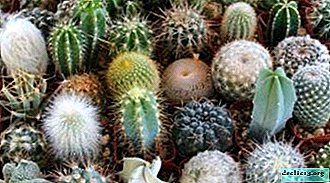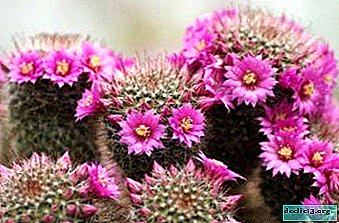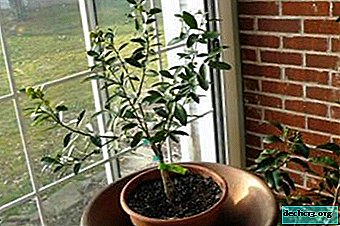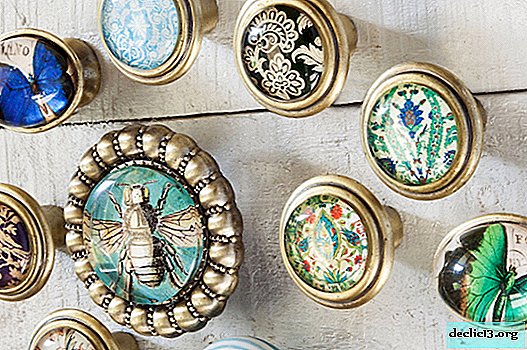How to protect your favorite cactus from diseases and pests? Diagnosis, treatment and prevention tips
 In harsh natural conditions, cacti are practically not exposed to diseases and pests. But with the move to a temperate climate, the plant has to adapt in a new way. Often it starts to hurt, but at first it is impossible to notice. Only in advanced cases, the appearance of the cactus begins to give out its state. Sometimes it is overcome by pests.
In harsh natural conditions, cacti are practically not exposed to diseases and pests. But with the move to a temperate climate, the plant has to adapt in a new way. Often it starts to hurt, but at first it is impossible to notice. Only in advanced cases, the appearance of the cactus begins to give out its state. Sometimes it is overcome by pests.
Cactus diseases are associated with bacteria, viruses or fungi, but most often the fault is due to improper care of the plant. In the article we will talk about the diseases of the "green prickly friend" and their treatment, as well as about pest control, we will show a photo.
Flower rots
Two pathogens cause decay of the cactus:
- Fungus Phytophtoracactorum - It causes wet rot.
- Fungus Gloeosporiumopuntiae - causes dry rot.
Wet rot initially affects the root system of a prickly green plant.
In particular, there is a danger to the spread of the fungus during transplantation of the cactus. Therefore, in this period it is not recommended to water the plant for 5-6 days.
During this time, callus appears on the roots of the flower (a tissue that promotes the healing of damage), and the danger of decay disappears.
Often, wet rot develops against the background of frequent watering and low air temperature.
Attention! In this case, you need to remember one rule - the colder the air, the drier the ground at the cactus.Dry rot develops in the inner part of the stem. Therefore, it is immediately impossible to recognize the disease. At the last stage of the disease, the stem begins to dry out from the inside.
Dry rot spreads against the background of cold and damp.
The photo below shows what dry rot of a cactus looks like:

And this is wet rot:

Turns yellow
The top of the cactus or its shoots begins to turn yellow. The cause of the disease can be:
- Pests.
- The disease.
- Lack of useful components in the soil.
If the reason is the lack of fertilizer in the soil, then you need to quickly correct this omission.
It's not so easy to cope with yellowness, even if the treatment is carried out according to the rules. The people called this disease "jaundice", it can occur from several weeks to several years.
If you take a stalk from a sick cactus, then there is a high probability that it will turn yellow over time.
It looks like a cactus that turns yellow:

Read more about how to understand why a cactus turns yellow, and whether it is dangerous, read here.
Dries
Initially, the stem begins to dry. First of all, it is necessary to exclude the factor of scarce watering. The lack of moisture is more intense if the plant is on the sunny side of the windowsill.
If, when the cactus dries, the stem is soft to the touch, the problem may be an excess of moisture. It is recommended to transplant the flower as soon as possible and remove the rotten parts of the roots.
This is a cactus that dries:

Getting soft
Reference. Cactus becomes soft most often due to heavy watering.Cacti grow in arid zones, therefore, do not require abundant moisture. Before the next watering, the soil should dry completely.
Why do spots appear and how to treat them?
Spotting most often occurs as a result of improper care of the plant. Mainly affect this condition:
- drafts;
- high humidity;
- low temperatures.
Brown
This condition is called anthrocnosis, or brown spotting. Spots can be light or dark, they spread throughout the cactus.
Spotted spots are depressed and dry. Over time, they grow and grow into large sections.
If brown spots appear on the plant, so that the disease does not spread further:
- the affected parts are cut out;
- cut points are treated with activated carbon;
- after that, the flower is sprayed with fungicides.
After such work, small dents will remain on the cactus, but in general it will be saved (why the cactus dies and how to save it, read here).
In the photo below - a cactus affected by anthrocnosis:

Whites
Sometimes whitish spots appear on the flower. This may be due to the spread of the tick.that appears in the presence of heat.
To get rid of it, you should:
- ventilate the room well and lower the air temperature to 10-12 degrees;
- if the disease is already running, then chemicals that can be purchased at the flower shop will help.
So the white spots on the cactus look:

Black
Black spots appear due to soil alkalization. That is, watering is carried out with water, in which there is an excess of calcium salts.
Attention! Such a plant will need to be transplanted urgently.In the photo below - black spots on a cactus:

Rusty
They resemble orange stains or rusty crusts. This condition can be caused by two main reasons:
- sunburn;
- cold water entering the stem.
Rusty spots can spread throughout the flower, so you need to take action immediately when they are detected.
In this case, you can use fungicides. They spray a flower. But sometimes they do not help. There is another way - you need to purchase a product called "Topaz", it is more effective in combating rust.
Rusty spots may look like this:

What if a green friend fades?
Sometimes the cause of wilting cactus is a banal lack of water.
Dry soil is watered, and excess fluid comes out through the holes in the pot.
Important! If the soil is sufficiently moistened, then the cause may be the so-called etiolation. With it, the rounded and stalk-shaped parts of the cactus narrow. In this case, it is necessary to provide the plant with an influx of sunlight.This is a cactus that fades:

Fungus problem
The fungus most often contributes to the spread of rot on the plant. The reasons are cold weather and waterlogging of the soil. The most common fungal infections:
- Late blight - decay begins with the neck of a cactus. The treatment consists in cutting off the rotted parts of the flower up to healthy tissues. After they are dried and rooted.
- Fusarium - the root system is affected. The cactus stops growing, becomes rusty, the turgor softens. The cactus is treated with fungicides, isolated from other plants, placed in a dry and warm room.
- Helminthosporosis - affects crops in the spring. This is facilitated by increased humidity and low temperatures. Treatment consists in removing contaminated soil. If it is suspected that the seedlings are infected, they are removed from the soil and watched for some time.
In this case, the air should be dry and warm, the plants themselves do not touch each other. If diseased seedlings were found, they are harvested, and only healthy plants are planted in the soil.
This is how a cactus affected by a fungal infection looks like:

Difficulties with growth and recommendations to owners
Sometimes a cactus has certain growth problems. This happens for certain reasons.
Not growing
Cactus growth is largely influenced by various minerals and trace elements. They are in plant nutrition.
- with a lack of nitrogen, the cactus stem will slowly grow;
- lack of phosphorus slows down growth, the plant turns pale;
- with a lack of calcium, the cactus root grows poorly.
They stop the development of cactus or slow down its lack of boron, copper, iodine and chlorine. All these trace elements are present in sufficient quantities in fertilizers for cacti. They must be added according to the instructions.
Stretched out
With a lack of lighting, the plant stem is deformed. He begins to reach for the light source, so it turns out to be elongated. You can correct the situation by placing a pot of cactus on a light windowsill and rooting the cut top.
Here is a cactus that has stretched:

Bent down
Cactus can lean over due to rotting of the root systemthat does not hold the plant properly. Remove the flower from the pot and inspect the root. In the presence of decayed areas, they are removed.
This is a cactus that bent over:

About why the cactus extended or bent and how it can be straightened, read here.
Falls on its side
Due to abundant watering, the cactus can stretch up and soften, as a result, it falls to its side. In this case, replanting and reducing irrigation will help.
Helminthosporiosis can also be the cause. In this case, the dried-up areas are cut off, the plant is transplanted into a new, previously disinfected, land.
This is a cactus falling on its side:

Broke in the middle - what to do with the top?
It looks like a plant that has broken in the middle:

If the flower is broken, then you can try to root the top.
Watch a video on how to root a cactus chip:
Why do the thorns disappear and how to solve the problem?
The cactus can fall thorns due to lack of calcium in the soil. If the plant is strong, then it can be transplanted into another substrate and add to the last crushed eggshell. Previously, it can be calcined in the oven. For young plants, as a prophylaxis, crushed shells can also be added to the drainage.
It looks like a plant that has lost part of the thorns:

Pests
Mostly the cactus infects the spider mite or the insect.
Worms can be recognized by white spots resembling powder, as they gather in groups. This is what this insect looks like:

Learn how to save a cactus from a mealybug and rid a plant of white plaque in this material.
A spider mite is a small red insect that cobwebs between spines of a cactus.
This is a spider mite:

The methods for controlling these insects are similar. For example, medical alcohol is taken and applied to the affected areas with a cotton swab.
In addition, in a pharmacy you can buy a tick remedy and apply against a spider mite.
To protect the cactus from diseases and pests, you need to properly care for the plant:
- Do not fill the cactus, do not allow moisture to enter the stem.
- The place of keeping the plant should be dry and sunny.
- Lack of light leads to stretching of the plant and its blanching.
- The soil needs to be disinfected, a new plant needs to be quarantined.
- Seeds are pickled before planting.
- For the purpose of prevention, the plant is periodically treated with fungicidal solutions.
If you create the right conditions for the cactus and take care of it properly, it will be healthy for many years.
Useful video
Watch a video on how to save a diseased cactus and what to do to prevent diseases and pests:

















